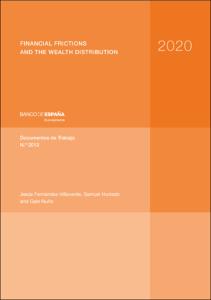Financial frictions and the wealth distribution
Authors
Issue Date
1-Jun-2020
Physical description
71 p.
Abstract
We postulate a nonlinear DSGE model with a financial sector and heterogeneous households. In our model, the interaction between the supply of bonds by the financial sector and the precautionary demand for bonds by households produces significant endogenous aggregate risk. This risk induces an endogenous regime-switching process for output, the risk-free rate, excess returns, debt, and leverage. The regime-switching generates i) multimodal distributions of the variables above; ii) time-varying levels of volatility and skewness for the same variables; and iii) supercycles of borrowing and deleveraging. All of these are important properties of the data. In comparison, the representative household version of the model cannot generate any of these features. Methodologically, we discuss how nonlinear DSGE models with heterogeneous agents can be efficiently computed using machine learning and how they can be estimated with a likelihood function, using inference with diffusions.
Este trabajo presenta un modelo DSGE no lineal con un sector financiero y hogares heterogéneos. En el modelo, las interacciones entre la oferta de bonos del sector financiero y la demanda de precaución de los hogares produce un riesgo endógeno significativo. Este riesgo induce un proceso de cambio de régimen endógeno para la producción, el diferencial de rentabilidad, la deuda y el apalancamiento. Este cambio de régimen genera: i) distribuciones multimodales para estas variables; ii) niveles variantes en el tiempo de la volatilidad y el sesgo de aquellas, y iii) superciclos de deuda y desapalancamiento. La versión del modelo con un agente representativo, en comparación, no puede generar ninguna de estas características, lo que destaca el papel central de la heterogeneidad en nuestro análisis. Metodológicamente, se discute como los modelos DSGE no lineales con agentes heterogéneos pueden resolverse de manera eficiente empleando técnicas de aprendizaje automático (machine learning) y como pueden estimarse mediante una función de verosimilitud, empleando inferencia con difusiones.
Este trabajo presenta un modelo DSGE no lineal con un sector financiero y hogares heterogéneos. En el modelo, las interacciones entre la oferta de bonos del sector financiero y la demanda de precaución de los hogares produce un riesgo endógeno significativo. Este riesgo induce un proceso de cambio de régimen endógeno para la producción, el diferencial de rentabilidad, la deuda y el apalancamiento. Este cambio de régimen genera: i) distribuciones multimodales para estas variables; ii) niveles variantes en el tiempo de la volatilidad y el sesgo de aquellas, y iii) superciclos de deuda y desapalancamiento. La versión del modelo con un agente representativo, en comparación, no puede generar ninguna de estas características, lo que destaca el papel central de la heterogeneidad en nuestro análisis. Metodológicamente, se discute como los modelos DSGE no lineales con agentes heterogéneos pueden resolverse de manera eficiente empleando técnicas de aprendizaje automático (machine learning) y como pueden estimarse mediante una función de verosimilitud, empleando inferencia con difusiones.
Publish on
Documentos de Trabajo / Banco de España, 2013
Subjects
Heterogeneous agents; Wealth distribution; Financial frictions; Continuoustime; Machine learning; Neural networks; Structural estimation; Likelihood function; Agentes heterogéneos; Distribución de la riqueza; Perturbaciones agregadas; Tiempo continuo; Aprendizaje automático; Redes neuronales; Estimación estructural; Función de verosimilitud; Fluctuaciones y ciclos económicos; Valoración de activos; Modelización econométrica
Appears in Collections:












